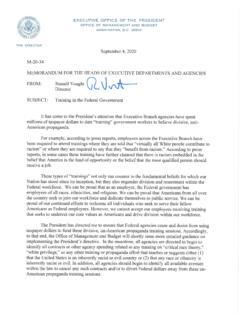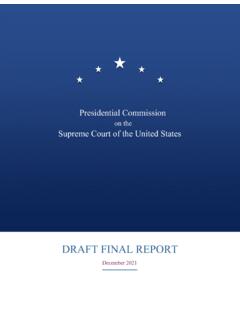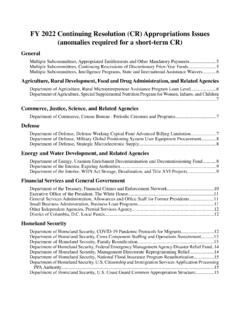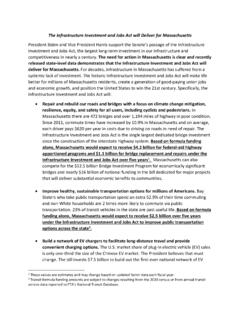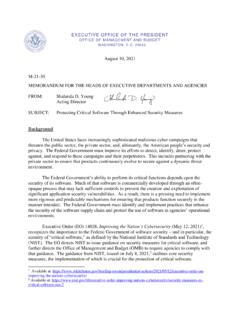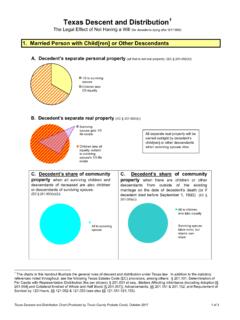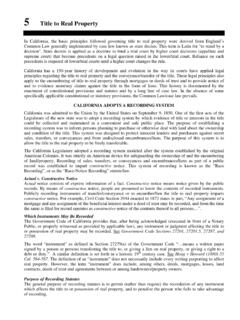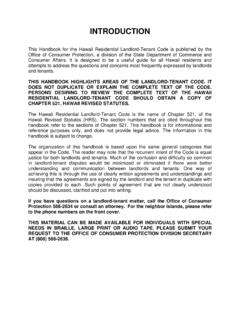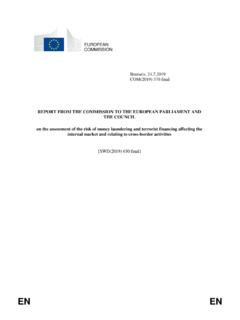Transcription of M-03-22, OMB Guidance for Implementing the Privacy ...
1 M-03-22, OMB Guidance for Implementing the Privacy provisions of the E-Government Act of 2002. September 26, 2003. M-03-22. MEMORANDUM FOR HEADS OF EXECUTIVE DEPARTMENTS AND AGENCIES. FROM: Joshua B. Bolten Director SUBJECT: OMB Guidance for Implementing the Privacy provisions of the E-Government Act of 2002. The attached Guidance provides information to agencies on Implementing the Privacy provisions of the E-Government Act of 2002, which was signed by the President on December 17, 2002 and became effective on April 17, 2003. The Administration is committed to protecting the Privacy of the American people.
2 This Guidance document addresses Privacy protections when Americans interact with their government. The Guidance directs agencies to conduct reviews of how information about individuals is handled within their agency when they use information technology (IT) to collect new information, or when agencies develop or buy new IT systems to handle collections of personally identifiable information. Agencies are also directed to describe how the government handles information that individuals provide electronically, so that the American public has assurances that personal information is protected.
3 The Privacy objective of the E-Government Act complements the National Strategy to Secure Cyberspace. As the National Strategy indicates, cyberspace security programs that strengthen protections for Privacy and other civil liberties, together with strong Privacy policies and practices in the federal agencies, will ensure that information is handled in a manner that maximizes both Privacy and security. Background Section 208 of the E-Government Act of 2002 (Public Law 107-347, 44 Ch 36) requires that OMB issue Guidance to agencies on Implementing the Privacy provisions of the E-Government Act (see Attachment A).
4 The text of section 208 is provided as Attachment B to this Memorandum. Attachment C. provides a general outline of regulatory requirements pursuant to the Children's Online Privacy Protection Act ("COPPA"). Attachment D summarizes the modifications to existing Guidance resulting from this Memorandum. A complete list of OMB Privacy Guidance currently in effect is available at OMB's website. As OMB has previously communicated to agencies, for purposes of their FY2005 IT budget requests, agencies should submit all required Privacy Impact Assessments no later than October 3, 2003.
5 For any questions about this Guidance , contact Eva Kleederman, Policy Analyst, Information Policy and Technology Branch, Office of Management and Budget, phone (202) 395-3647, fax (202) 395-5167, e- mail Attachments Attachment A. Attachment B. Attachment C. Attachment D. Attachment A. E-Government Act Section 208 Implementation Guidance I. General A. Requirements. Agencies are required to: a. conduct Privacy impact assessments for electronic information systems and collections and, in general, make them publicly available (see Section II of this Guidance ), b. post Privacy policies on agency websites used by the public (see Section III), c.
6 Translate Privacy policies into a standardized machine-readable format (see Section IV), and d. report annually to OMB on compliance with section 208 of the E-Government Act of 2002 (see Section VII). B. Application. This Guidance applies to: a. all executive branch departments and agencies ("agencies") and their contractors that use information technology or that operate websites for purposes of interacting with the public;. b. relevant cross-agency initiatives, including those that further electronic government. C. Modifications to Current Guidance . Where indicated, this Memorandum modifies the following three memoranda, which are replaced by this Guidance (see summary of modifications at Attachment D): a.
7 Memorandum 99-05 (January 7, 1999), directing agencies to examine their procedures for ensuring the Privacy of personal information in federal records and to designate a senior official to assume primary responsibility for Privacy policy;. b. Memorandum 99-18 (June 2, 1999), concerning posting Privacy policies on major entry points to government web sites as well as on any web page collecting substantial personal information from the public; and c. Memorandum 00-13 (June 22, 2000), concerning (i) the use of tracking technologies such as persistent cookies and (ii) parental consent consistent with the Children's Online Privacy Protection Act ("COPPA").
8 II. Privacy Impact Assessment A. Definitions. a. Individual - means a citizen of the United States or an alien lawfully admitted for permanent b. Information in identifiable form- is information in an IT system or online collection: (i) that directly identifies an individual ( , name, address, social security number or other identifying number or code, telephone number, email address, etc.) or (ii) by which an agency intends to identify specific individuals in conjunction with other data elements, , indirect identification. (These data elements may include a combination of gender, race, birth date, geographic indicator, and other descriptors).
9 2. c. Information technology (IT) - means, as defined in the Clinger-Cohen Act3, any equipment, software or interconnected system or subsystem that is used in the automatic acquisition, storage, manipulation, management, movement, control, display, switching, interchange, transmission, or reception of data or information. d. Major information system - embraces "large" and "sensitive" information systems and means, as defined in OMB Circular A-130 (Section ) and annually in OMB Circular A-11 (section 300-4. (2003)), a system or project that requires special management attention because of its: (i) importance to the agency mission, (ii) high development, operating and maintenance costs, (iii) high risk, (iv) high return, (v) significant role in the administration of an agency's programs, finances, property or other resources.
10 E. National Security Systems - means, as defined in the Clinger-Cohen Act4, an information system operated by the federal government, the function, operation or use of which involves: (a) intelligence activities, (b) cryptologic activities related to national security, (c) command and control of military forces, (d) equipment that is an integral part of a weapon or weapons systems, or (e) systems critical to the direct fulfillment of military or intelligence missions, but does not include systems used for routine administrative and business applications, such as payroll, finance, logistics and personnel management.


